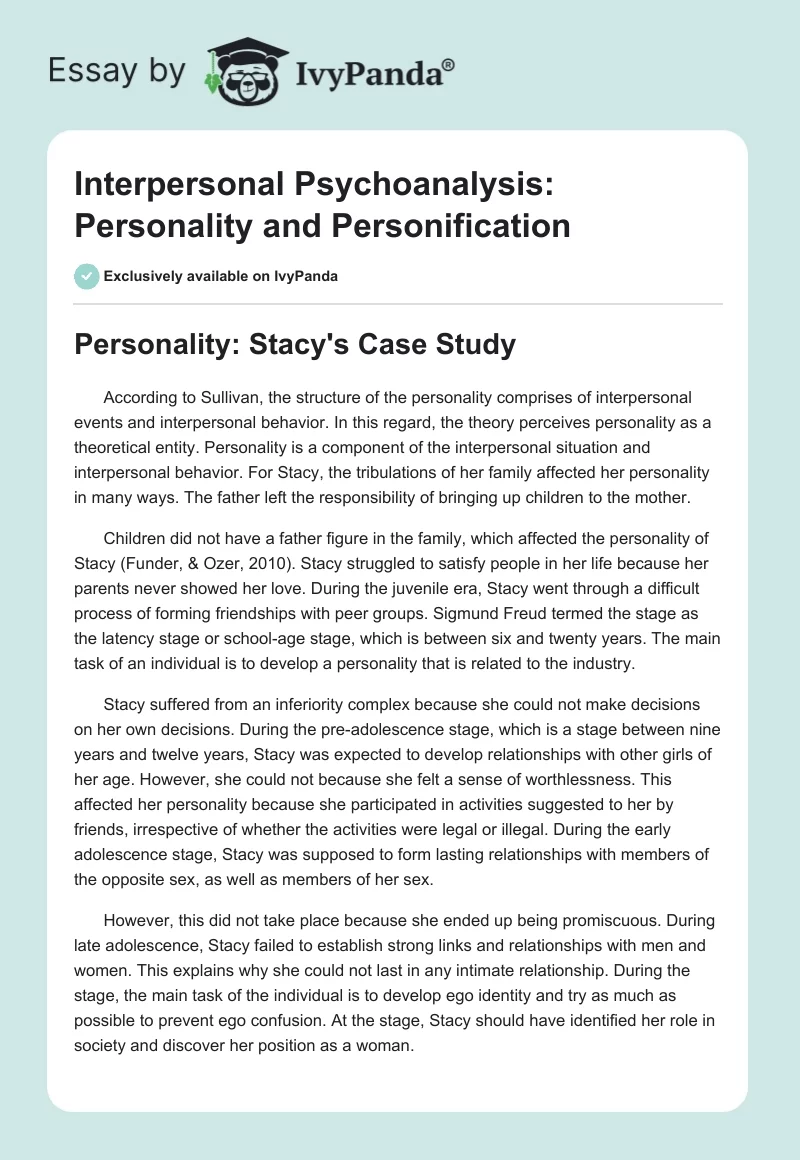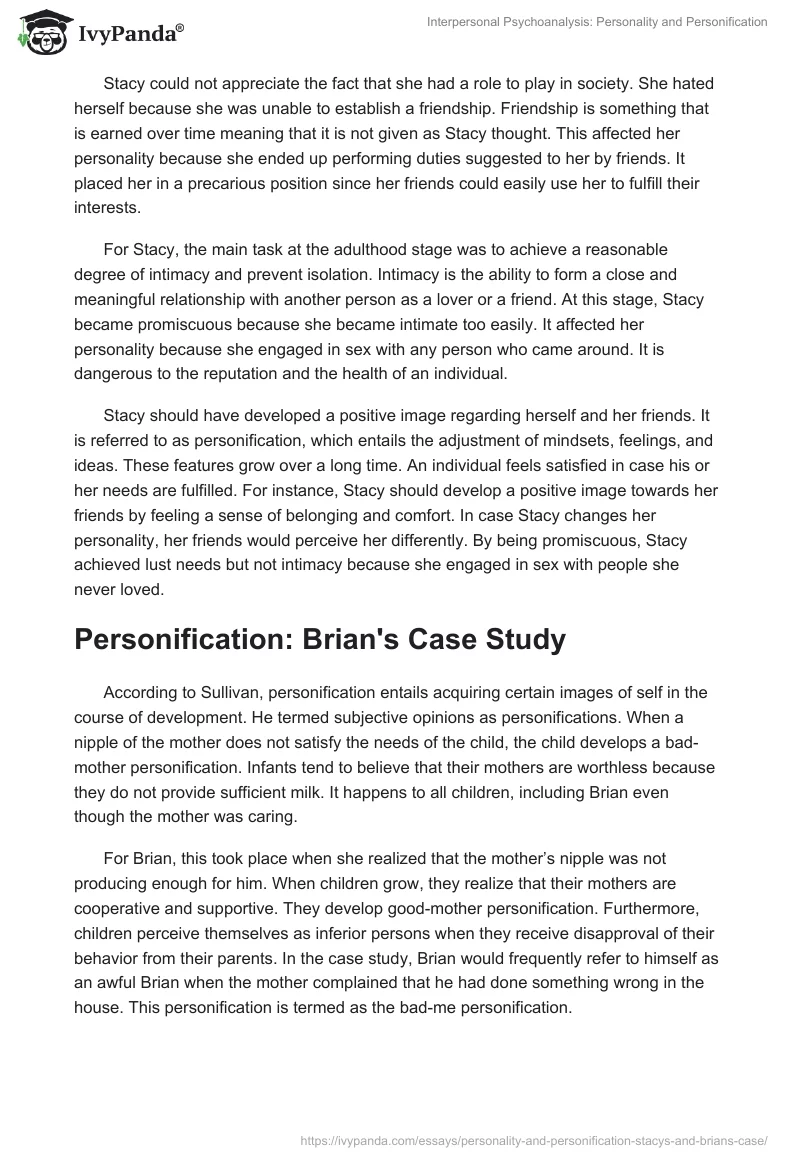Personality: Stacy’s Case Study
According to Sullivan, the structure of the personality comprises of interpersonal events and interpersonal behavior. In this regard, the theory perceives personality as a theoretical entity. Personality is a component of the interpersonal situation and interpersonal behavior. For Stacy, the tribulations of her family affected her personality in many ways. The father left the responsibility of bringing up children to the mother.
Children did not have a father figure in the family, which affected the personality of Stacy (Funder, & Ozer, 2010). Stacy struggled to satisfy people in her life because her parents never showed her love. During the juvenile era, Stacy went through a difficult process of forming friendships with peer groups. Sigmund Freud termed the stage as the latency stage or school-age stage, which is between six and twenty years. The main task of an individual is to develop a personality that is related to the industry.
Stacy suffered from an inferiority complex because she could not make decisions on her own decisions. During the pre-adolescence stage, which is a stage between nine years and twelve years, Stacy was expected to develop relationships with other girls of her age. However, she could not because she felt a sense of worthlessness. This affected her personality because she participated in activities suggested to her by friends, irrespective of whether the activities were legal or illegal. During the early adolescence stage, Stacy was supposed to form lasting relationships with members of the opposite sex, as well as members of her sex.
However, this did not take place because she ended up being promiscuous. During late adolescence, Stacy failed to establish strong links and relationships with men and women. This explains why she could not last in any intimate relationship. During the stage, the main task of the individual is to develop ego identity and try as much as possible to prevent ego confusion. At the stage, Stacy should have identified her role in society and discover her position as a woman.
Stacy could not appreciate the fact that she had a role to play in society. She hated herself because she was unable to establish a friendship. Friendship is something that is earned over time meaning that it is not given as Stacy thought. This affected her personality because she ended up performing duties suggested to her by friends. It placed her in a precarious position since her friends could easily use her to fulfill their interests.
For Stacy, the main task at the adulthood stage was to achieve a reasonable degree of intimacy and prevent isolation. Intimacy is the ability to form a close and meaningful relationship with another person as a lover or a friend. At this stage, Stacy became promiscuous because she became intimate too easily. It affected her personality because she engaged in sex with any person who came around. It is dangerous to the reputation and the health of an individual.
Stacy should have developed a positive image regarding herself and her friends. It is referred to as personification, which entails the adjustment of mindsets, feelings, and ideas. These features grow over a long time. An individual feels satisfied in case his or her needs are fulfilled. For instance, Stacy should develop a positive image towards her friends by feeling a sense of belonging and comfort. In case Stacy changes her personality, her friends would perceive her differently. By being promiscuous, Stacy achieved lust needs but not intimacy because she engaged in sex with people she never loved.
Personification: Brian’s Case Study
According to Sullivan, personification entails acquiring certain images of self in the course of development. He termed subjective opinions as personifications. When a nipple of the mother does not satisfy the needs of the child, the child develops a bad-mother personification. Infants tend to believe that their mothers are worthless because they do not provide sufficient milk. It happens to all children, including Brian even though the mother was caring.
For Brian, this took place when she realized that the mother’s nipple was not producing enough for him. When children grow, they realize that their mothers are cooperative and supportive. They develop good-mother personification. Furthermore, children perceive themselves as inferior persons when they receive disapproval of their behavior from their parents. In the case study, Brian would frequently refer to himself as an awful Brian when the mother complained that he had done something wrong in the house. This personification is termed as the bad-me personification.
Brian would claim that he was a marvelous person when the mother congratulated him for treating people well. Brian would jump up and claim that he was a brilliant boy. This is what psychologists refer to as the good-me personality.
Sullivan suggested that dynamism could be used to explain the behavior and experiences of an individual in society. For Brian, the self-system helped him in interacting with his mother. The self-system has the main role of protecting the self from anxiety (Sullivan, 1953).
Equally, the behavior of Tammy could be understood through the application of the self-system. All experiences that were inconsistent with her behavior were reduced through the application of security systems, such as dissociation and selective inattention. She could have created conflicts with her husband during the birth of Brian, but she blocked them through self-awareness.
References
Funder, D., & Ozer, D. (2010). Pieces of the personality puzzle. New York: W.W. Norton.
Sullivan, H. (1953). The Interpersonal Theory of Psychiatry. New York: W. W. Norton.


